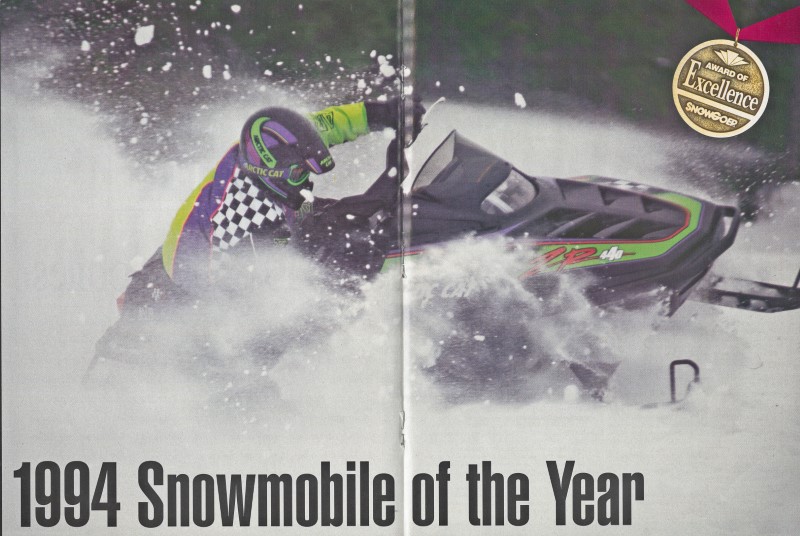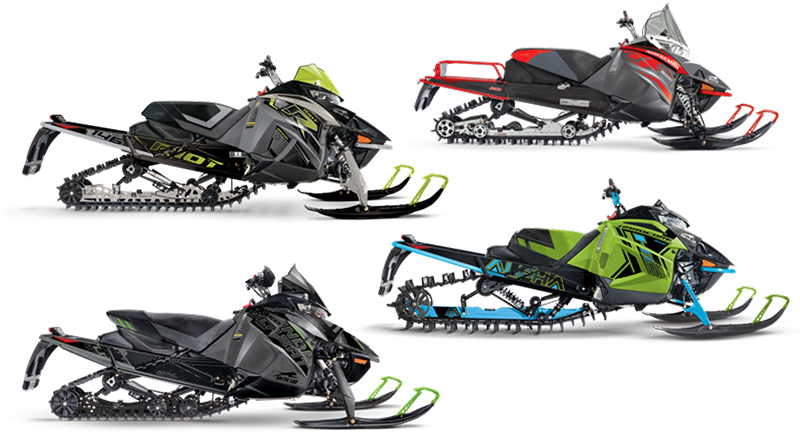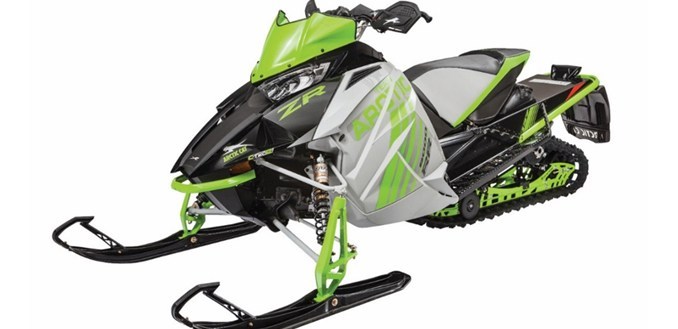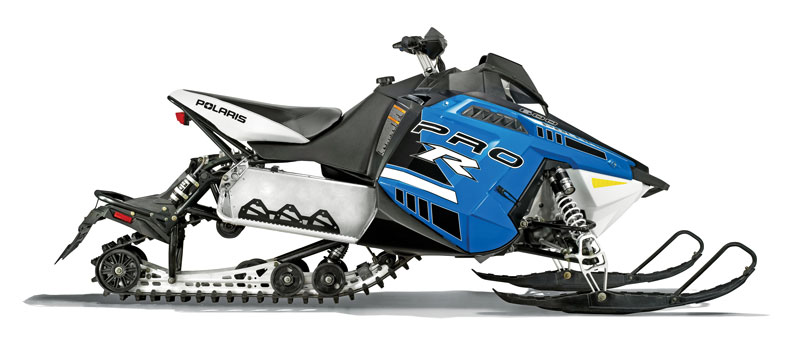Crossfire R Models Hark Back The Firecat
The new Crossfire R starts with a Crossfire chassis. But instead of the boondocker handlebar arrangement, there’s a set of low, flat bars conducive to hunkered-down trail and lake runs. And instead of the tall-lugged dual-purpose on-/off-trail track is a narrow and speedy 14- by 128- by 1-inch Camoplast Challenger track.
The Crossfire Rs are a new sled and really do nail the claim that Arctic Cat has a modern Firecat in its product brochure. Keep in mind, though, that while we have very fond memories of the Firecats, they aren’t the latest and greatest sleds. Arctic Cat knew the same thing, so engineers improved the handling, stability and ergonomics over what the Firecats offered.

The two Crossfire R models — 1000 and 800 — corner better than the Firecats.
They carve and hold lines well, but with some inside ski lift, which bothers some riders more than others. Because riders aren’t in the middle of the sled like the newer rider-forward chassis, bumps are felt both front and rear rather than as one unitized suspension system. R’s are more predictable and stable than the Firecats, but the Crossfire R is more fatiguing to ride in the bumps than anything Twin Spar.

In terms of rider comfort, it was downright frustrating that the footwells are so shallow. All of our test drivers would have preferred to get their feet more forward. The footwells are almost incompatible with the rider position, which cheats the driver a bit forward on the seat but without adequate room for the feet.
We’re not shredding the Crossfire Rs. These sleds were to fill a void in the Cat lineup that its customers wanted: a lightweight, speedy trail sled.
Recognizing there are some compromises to comfort, the 800 and 1000 Crossfire R models accomplish the light and fast goals. While the Crossfire R is a fabulous trail scalpel, if you prioritize comfort and a better sled for more than fast riding on smooth trails, stick with the F-Series.

New Z1 Turbo Engine Launches Powerful New Models
There are a lot of rumors we dismiss, and then there are some that we hope come true. Such was the case of a turbo-powered Jaguar. When we first heard of its possible release, we couldn’t wait to see if Cat would actually uncork one for snowmobiler consumption. As it turns out, there are three models that use the new four-stroke turbo engine: the base model Z1 Turbo, the better-equipped Z1 Turbo LXR and the top-shelf TZ1 Turbo Touring LXR.
While the Jaguar moniker isn’t in its name, the fact is the new Z1 Turbo is the most powerful full-production sled from any factory, ever.

Cat’s powertrain designers worked on this one from the beginning and had the Jaguar’s 1056cc twin built to accommodate the turbine and the necessary plumbing, including an intercooler.
Yes, that added hardware adds weight. This machine drives a little heavier than the two-stroke counterparts simply because they are, but neither sled nor driver cares when beckoning the peak 177 hp at 7850 rpm and a steam-rolling torque spec of 121 pound-feet at 7300 rpm. The sled pulls through to the top and power sneaks up on the driver. It’s easy to see why when looking at the sled’s dyno specs.
There are more than 100 pound-feet on tap over the 4000 to 8000 rpm spread.
Accessing 100 mph on snow hasn’t been as easy or as comfortable on a turn-key production sled. With altitude and atmospheric pressure changes, the turbo compensates to maintain peak power at any elevation. Because air density thins with increased elevation, the turbo spins faster to help achieve the result. Cat claims a turbo system that maintains boost and power to the elevation extremes programmed into its system is quite rare, and pointed out that many automotive and truck turbo applications start peak power degradation at 7,500 feet.

Comfort comes with the normal Twin Spar niceties on the base model Z1 Turbo. Like the F-Series sleds of the past few model years, an LXR version provides the adjustable (and heated) seat and handlebars. The TZ1 Turbo Touring LXR is the top-of-the-line touring machine that handles and drives exceptionally well in 2-Up mode. The huge power on tap was a bonus. We aren’t done reporting on this significant machine. We’ll have a full comparison of the top touring models in our January issue.
Sharper Twin Spar Handling
For the second time in as many years, chassis engineers went to work to better dial in the handling. First versions of the Twin Spar Cats for the 2007 model year were slow to steer and pushed in corners. Last year’s sway bar change improved it.
In 2009, Arctic Cat is removing things for us to bark about with the F-Series handling. The Fs now corner as light and flat as before, but with added precision and, finally, predictability to the front end. The latest improvement came from “tipping” the chassis. The slight geometry revision stood the spindle angle 1.5 degrees more upright. In effect, it shortens the wheelbase a bit. The A-arms lay flatter for better lateral stability.
The running board clearance increased while rider comfort improved because of a 2.5-degree reduction on the running board angle. Rear suspension revisions include a change to the rail profile for faster track speeds. It’s the same attack angle, but the surface is smoothed out, which also reduces hyfax wear. A longer limiter strap gives customers a wider range of adjustment. The rear arm was moved about 2.5 inches rearward as well to accommodate the tunnel revision.
From the seat, it was hard to pinpoint any specific rear skid benefits. But there is an obvious handling improvement with the sum of the changes. The result is a better bite on the snow, both hardpack and loose slop, for better cornering. Steering is still light enough to feel like you’re cheating against the other manufacturers, even on the big-bore 1000 and the heavier four strokes.
Arctic Cat Engine Reverse
New spin-backward engine technology removes 7.5 pounds worth of reverse gears. There were a total of 49 parts removed, but keep in mind some of those parts are washers and O-rings. All totaled however, the full Arctic Cat Engine Reverse (ACER) upgrade is about 10 pounds less without changing the ACT Drive system case. This means the upgraded forward-only ACT drive will retrofit to 2007 and 2008 model year sleds.
The ACER works the same as the Rotax and Polaris versions. Push a button, the engine idles down and changes direction to drive the clutches in reverse. Because the clutches spin backward on the ’09s, the cam in the secondary was cut to have a lock position that prevents the sheaves from opening. This limits reverse speeds. There’s nothing new here in approach, but the ACER has an advantage or two over the other manufacturers’ systems.
ACER has a faster engagement to decrease the likelihood of a stall. Also, reverse cannot be activated during forward motion for an unintended stop with the reverse beep audible to alert riding companions to the blunder.

M-Series And Crossfire Improvements
Already lightweight sleds, Crossfires got a rear suspension overhaul that took 9.5 pounds from the standards. The Sno Pro version of the Crossfire skid uses a Fox FLOAT shock on the rear arm that brings the total reduction to 17.5 pounds. Combined with the ACER upgrade, the Crossfires are significantly lighter.
Now a 141-inch track in place of the 136, the new length combined with new 8-inch rear axle wheels puts about one more lug on the ground. Tunnels are tapered and 4 inches shorter. A revised snow flap ensures the correct snow evacuation and cooling effect and a new LED taillight gives trailing riders better visibility through the snow dust.
A new telescoping steering column, Vertical Speed Bars (VSB), is a fresh idea from the “why didn’t anyone think of it sooner” department. A stainless steel hex shaft has a total of 12 detents over a 4-inch range so riders can match handlebar height for the terrain or conditions. The feature is available on M-Series and Crossfire Sno Pro models.
There is some play in the steering post, but that is unavoidable due to the moving parts that make the system work. It was easy to detect the slight jiggle when the sled was parked but it does nothing to effect steering or other handling inputs when in motion. We were assured that the telescoping post is every bit as strong as a normal post and have no reason to doubt it.

The M-Series sleds lose weight this year, up to 22 pounds according to the model. The ACER upgrade leaves 10 pounds on the shelf. Machined rails and the move to two rear axle idler wheels account for another 3.5 pounds.

The M-Series sleds have never felt heavy or cumbersome. While tough to feel the lighter weight from the cockpit, it’s appreciated most when digging out.
And because the Power Claw track worked so well in our testing, we think that should happen less frequently. The new track is 10 pounds lighter, which helps get more peak power to the ground and makes the engine more responsive —?needed, especially, for the 600. Though top speed is competitive, the mid-range pull on the 600 falls short of the Rotax and Polaris Liberty engines. While it has a healthy midrange pull, the 145 hp spec of the 800 mill no longer matches the output of the other 800 two-strokes.





